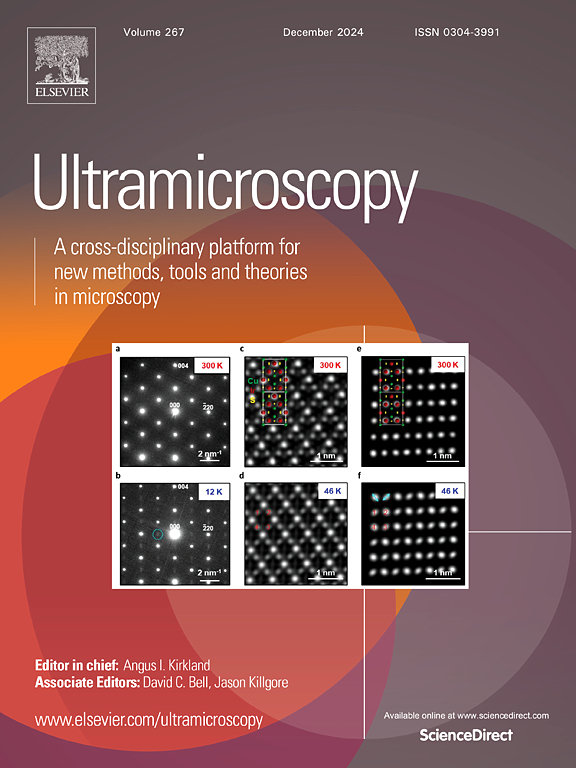Simulation study of the performance of neural network-enhanced PACBED for characterizing atomic-scale deformations in 2D van der Waals materials
IF 2
3区 工程技术
Q2 MICROSCOPY
引用次数: 0
Abstract
Two dimensional (2D) van der Waals (vdW) materials have attractive mechanical, electronic, optical, and catalytic properties that are highly tunable especially when they are thin. However, they are rarely perfect and flat, and their properties are strongly influenced by local crystal lattice deformations that include the 2D strain tensor, in-plane rotation and corrugation, where the latter is manifested as local sample tilt. Therefore, to gain more control over their properties, a detailed understanding of these deformations is needed. Position averaged convergent beam electron diffraction (PACBED) is a powerful technique for providing information about local atomic structure. In this work, we perform a comprehensive simulation study of the performance of PACBED in combination with convolutional neural networks (CNNs) for prediction of deformations of 2D materials. We generate around 100,000 simulated PACBED patterns from 2H MoS for thicknesses from 1 to 20 atomic layers where strain, rotation, and tilt parameters are varied. Five convergence angles are explored which vary from conventional nano beam electron diffraction (6.35 mrad) to atomic resolution conditions (32.94 mrad). From this simulated PACBED library, we train regression CNNs to simultaneously predict the 2D strain tensor, in-plane rotation, and tilt of the sample. For different convergence angles and thicknesses, we study the prediction performance for each of the deformation parameters. We find that there is a trade-off between better prediction performance (small convergence angles) and probe size (large convergence angles). For smaller convergence angles like those used for conventional NBED conditions, the strain prediction error can be as low as 0.0003 %, while for larger convergence angles like those used for atomic resolution probes, the strain error increases to 0.001 - 0.003 %. The impressive prediction performance even for large convergence angles suggests that PACBED combined with CNNs is a feasible method for predicting deformation parameters using atomic resolution electron probes. Further, we conclude that the prediction can be difficult for monolayers, and suggest two remedies: excluding tilt from the predictions and performing nonlinear intensity rescaling of the training data. This work contributes to the optimal design of PACBED experiments for characterization of local crystal deformations and, therefore, to an improved understanding of how 2D vdW materials respond to imperfections.
神经网络增强PACBED表征二维范德华材料原子尺度变形性能的仿真研究
二维(2D)范德华(vdW)材料具有吸引人的机械、电子、光学和催化性能,特别是当它们很薄时,它们是高度可调的。然而,它们很少是完美的和平坦的,它们的性质受到局部晶格变形的强烈影响,包括二维应变张量、面内旋转和波纹,其中波纹表现为局部样品倾斜。因此,为了更好地控制它们的特性,需要详细了解这些变形。位置平均会聚束电子衍射(PACBED)是一种提供局部原子结构信息的有力技术。在这项工作中,我们对PACBED与卷积神经网络(cnn)结合预测二维材料变形的性能进行了全面的模拟研究。我们从2H MoS2中生成了大约100,000个模拟PACBED图案,厚度从1到20原子层,其中应变,旋转和倾斜参数变化。从传统的纳米束电子衍射(6.35 mrad)到原子分辨率(32.94 mrad),探索了五个不同的会聚角。从这个模拟的PACBED库中,我们训练回归cnn来同时预测样本的二维应变张量、平面内旋转和倾斜。在不同的收敛角和厚度下,研究了各变形参数的预测性能。我们发现在更好的预测性能(小收敛角)和探针尺寸(大收敛角)之间存在权衡。对于较小的收敛角(如用于常规NBED条件的收敛角),应变预测误差可低至0.0003%,而对于较大的收敛角(如用于原子分辨率探针的收敛角),应变预测误差增加到0.001 - 0.003%。即使在大的收敛角下,PACBED与cnn结合的预测性能也令人印象深刻,这表明PACBED与cnn结合是一种利用原子分辨率电子探针预测变形参数的可行方法。此外,我们得出结论,单层预测可能很困难,并提出了两种补救措施:从预测中排除倾斜和对训练数据进行非线性强度重新缩放。这项工作有助于PACBED实验的优化设计,以表征局部晶体变形,从而提高对二维vdW材料如何响应缺陷的理解。
本文章由计算机程序翻译,如有差异,请以英文原文为准。
求助全文
约1分钟内获得全文
求助全文
来源期刊

Ultramicroscopy
工程技术-显微镜技术
CiteScore
4.60
自引率
13.60%
发文量
117
审稿时长
5.3 months
期刊介绍:
Ultramicroscopy is an established journal that provides a forum for the publication of original research papers, invited reviews and rapid communications. The scope of Ultramicroscopy is to describe advances in instrumentation, methods and theory related to all modes of microscopical imaging, diffraction and spectroscopy in the life and physical sciences.
 求助内容:
求助内容: 应助结果提醒方式:
应助结果提醒方式:


